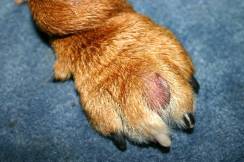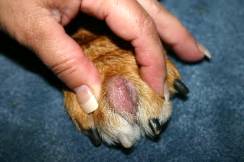Interdigital cysts


Interdigital Cysts are actually a cellulitic form of deep tissue pyoderma (skin infection). Cellulitus is a condition in which inflammatory fluids are forced into the tissues, rather than being discharged on the surface. Interdigital cysts are characterized as a firm, nodular thickening of the interdigital web. These cysts generally exhibit active stages of deep draining tracts of large pustules in one or more interdigital spaces.
Interdigital pyoderma tends to be chronic in nature, therefore a thorough search for the underlying cause is essential. This search can consist of skin scrapings, bacterial cultures and sensitivity tests. Most often the causative factors are found to be infection with staphylococci, ingrown hairs or blockage of a sebaceous gland. Though in some cases a genetic predisposition is suspected, which will necessitate intermittent lifelong antibiotics to control the symptoms. In some cases, the cyst is removed under general anesthesia followed up by appropriate antibiotics.
In many cases, interdigital cysts can be eleviated, if only temporarily, by home treatment. Home treatment should not be attempted by novices, it is however a step available to those experienced in dogs and the possible repercussions of interdigital cysts. The following is a brief outline of one fairly successful home treatment course.
a) first thoroughly clean the area.
b) soak the paw in warm water with Epsom Salts. Some people find it easiest to soak all 4 feet at the same time by standing the dog in a bath tub.
c) Do not allow the dog to drink the water.
d) Soak for approximately 10 minutes.
e) Dry area thoroughly.
f) apply Panalog ointment to the area or use preparation H.
g) repeat daily until swelling has been gone.







